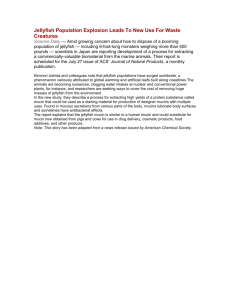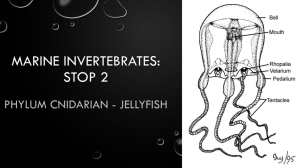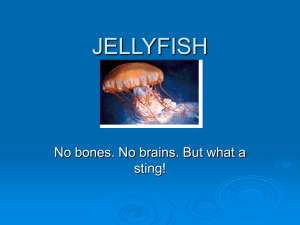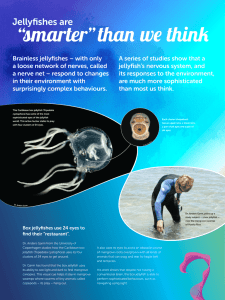AquaJelly
advertisement
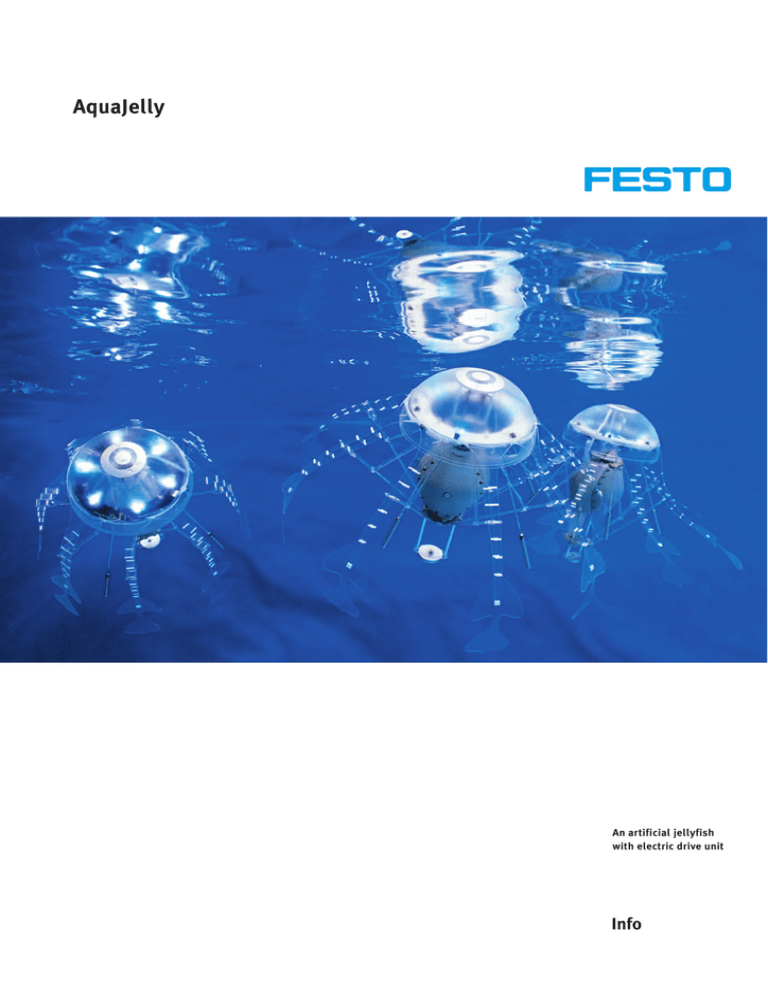
AquaJelly An artificial jellyfish with electric drive unit Info An autonomously controlled jellyfish Eight Fin Ray ® tentacles with rhombic joint mechanism Jellyfish are fascinating creatures that consist of water to approximately 99 percent. Over the course of millions of years, they have efficiently adapted to the most varied of environments in both salt and fresh water. The construction of an artificial jellyfish can at best only be seen as an attempt to gain further insights into these fascinating marine creatures and to learn from them. AquaJelly is an artificial autonomous jellyfish with an electric drive unit and an intelligent adaptive mechanism that emulates swarming behaviour. It consists of a translucent hemisphere, a central watertight body and eight tentacles for propulsion. AquaJelly’s translucent hemispherical dome houses an annular control board with integrated, pressure, light and radio sensors. The orientation of the propulsion system is constantly monitored by a processor. The control board also contains 8 white and 8 blue LEDs, which together with the sensors allow communication between several AquaJellies. On the outside, AquaJelly has two concentric silver rings coated with conductive metal paint; connected to these is a charging control unit that supplies the jellyfish with energy. When AquaJelly approaches a charging station located above the water surface, it is drawn towards it and supplied with electricity. The charging station itself consists of an ESS vacuum generator from Festo with integrated contact points for transferral of the energy for charging. The AquaJellies communicate with the charging station to ensure that each jellyfish is supplied with sufficient energy. The central component of AquaJelly is a watertight laser-sintered body that houses a central electric motor, the two lithium-ion polymer 2 accumulator batteries, the charging control unit and the actuators for the swash plate. A full recharging procedure takes around three hours. Via two cranks, the electric motor powers drive plates attached to the top and the underside of the watertight body; the cranks are configured at a 60-degree angle. Connected to the drive plates are eight rhombic joints which set the tentacles in wavelike motion. The tentacles are designed as structures on FinRay Effect ® – a construction derived from the functional anatomy of a fish’s fin. The actual structure consists of two alternating tension and pressure flanks connected by ribs. If a flank is put under tension, the geometrical structure automatically bends in the direction of the applied force. The delayed activation of the eight tentacles via the rhombic joints gives rise to a regular wavelike motion, which generates propulsion. The tentacles together produce a peristaltic forward motion similar to that of their biological model. Controlling AquaJelly’s motion in three-dimensional space is effected by weight displacement. For this purpose, two actuators integrated into the central watertight body control a swash plate, which in turn operates a four-armed pendulum that can be moved in four spatial directions. When the pendulum moves in a particular direction, AquaJelly’s centre of mass is displaced accordingly – the jellyfish then moves in the direction of the pendulum’s displacement. By means of this peristaltic motion, AquaJelly can move in any spatial direction. Energy transfer via two integrated contact points Control board with infrared LEDs The jellyfish’s sensor system comprises three components that use different media. A pressure sensor makes it possible to determine AquaJelly’s depth in the basin to within a few millimetres. AquaJelly is thus aware of its precise position at all times and can position itself within a specific pressure zone. It also relies on the pressure sensor for recharging, since this is the only way it can strategically swim to the surface. For communication at the water’s surface AquaJelly uses the energy-saving ZigBee ® short-range radio system, which enables it to exchange data with the charging station and to signal to other AquaJellies at the surface that the station is occupied. The radio waves penetrate to a physically determined minimal depth, and AquaJelly must decide within a narrowly defined range which charging station it will approach. A central electric propulsion unit, combined with an intelligent adaptive mechanism and intelligent autonomous electronics, would be feasible as new applications for autonomously controlled systems. If several AquaJellies are endowed with a communicative faculty, they can act as a swarm, which then behaves as a system with a higher order of development. If this principle is extended to automation, many autonomous or partly autonomous intelligent systems could work together to solve large-scale problems by strategic cooperation between small systems. Nevertheless, the principal communication medium under water is light. AquaJelly is fitted with eleven infrared light-emitting diodes located on a ring inside its dome. On the basis of the 20° aperture angle of these diodes and using pulsed infrared signals. AquaJelly can communicate within an almost spherical surrounding space to a distance of about 80 cm. When it receives a positional signal from another approaching jellyfish, for example, AquaJelly can thus take evasive action in good time. In addition to the sensors that monitor its surroundings, AquaJelly is also fitted with an internal sensor system that monitors its energy condition, and a solenoid switch that enables it to register the orientation of the propulsion system. Each jellyfish decides autonomously on the basis of the prevailing conditions – which for example can depend on the charge condition, the propulsion system’s orientation or the proximity of another AquaJelly – what action is to be taken. Although the overall behaviour of a swarm of AquaJellies is emergent, i.e. arises without predetermined control, it results solely from a suitable choice of simple rules of behaviour for individual AquaJellies and represents a collective behaviour pattern that maximises the number of living jellyfish. AquaJelly exists within a spatially bound scenario with only a limited number of charging stations. In order to survive, the various AquaJellies must thus strive for an ideal, evenly distributed utilisation of these stations, in order to maximise the number of living jellyfish in the swarm. To secure the existence of the swarm in the water basin, it is therefore crucial to make maximum use of the space available, i.e. to avoid collision with other jellyfish and to utilise the charging stations in a well-coordinated manner. At the same time, AquaJelly can also react to all external influences. 3 Project partners Project initiator: Dr. Wilfried Stoll, Chairman of the Supervisory Board, Festo AG Mechanical design and construction of the jellyfish: Rainer and Günther Mugrauer, Clemens Gebert, Effekt-Technik GmbH, Schlaitdorf, Germany Autonomy and swarming behaviour: Institute of Parallel and Distributed Systems, University of Stuttgart Professor Dr. rer. nat. habil. Paul Levi, Dr. rer. nat. Serge Kernbach, Dipl.-Inform. Frank Schreiber, Dipl.-Inform. Kristof Jebens Technical data 1x microprocessor – communication by light – ATmega168, 8 MHz pulse, RAM 1 kbyte, flash memory 16 kbyte, 512 EEPROM 1x microprocessor – motor control – ATmega168, 8 MHz pulse, RAM 1 kbyte, flash memory 16 kbyte, 512 EEPROM 1x microprocessor – radio communication – ZigBit module from Meshnetics (ATmega 1281V RAM 8 kbyte, flash memory 128 kbyte, EEPROM 4 kbyte + transceiver AT86RF230RF) The electronic system operates at 3.6 V; the microprocessors communicate via an I2C bus. 1x pressure + temperature sensor. Manufacturer: VTI, type: SCP 1000, Precision: < 1 mm water depth 11x infrared transmission LEDs, total transmission power approx. 2 mW 11x infrared receiver units (PCM) Mechanical design and construction of the charging station, aquarium process technology: Uwe Neuhoff, Display Construction, Festo AG & Co. KG Henry Köllmann, Henry Köllmann Elektrik, Pneumatic, Electronic, Schwäbisch Gmünd, Germany Project Manager: Markus Fischer, Corporate Design Festo AG & Co. KG Aquarium construction: Walz GmbH, Leinfelden-Echterdingen, Germany Graphic Design: Atelier Frank, Berlin, Germany Photos: Walter Fogel, Angelbachtal, Germany Brands: Fin Ray Effect ® is a brand of Evologics GmbH 1x efficient, automatic accumulator battery monitor with integrated safety cut-off with Hot Swap® controller – LiPo protector – manufacturer: MAXIM, type: DS 2764; charge regulation – manufacturer: Texas Instruments, type: BQ 24100; Hot Swap® controller – manufacturer: Linear Technology, type: LTC4211 1x individually designed control board (round) 1x H-bridge power stage for main motor. Manufacturer: STMicroelectronics, type: L298, load capacity up to 3 A 2x actuators for directional steering, controlled directly by microprocessors Digital 3-axis acceleration sensor for 3D inclination control – manufacturer: ST Microelectronics, type: LIS302DL Accumulator batteries: lithium polymer, 4.2 V; capacity 4,000 mA Motor: bell-type armature motor, 3 V Transmission: upstream epicyclic gear set, ratio 1:180 Festo AG & Co. KG Ruiter Strasse 82 73734 Esslingen Germany Phone + 49 711 347-0 Telefax + 49 711 347-21 55 cc@ de.festo.com www.festo.com/bionic

